The information contained in the publications page are for educational purposes and is not a substitute for a consultation with a physician.
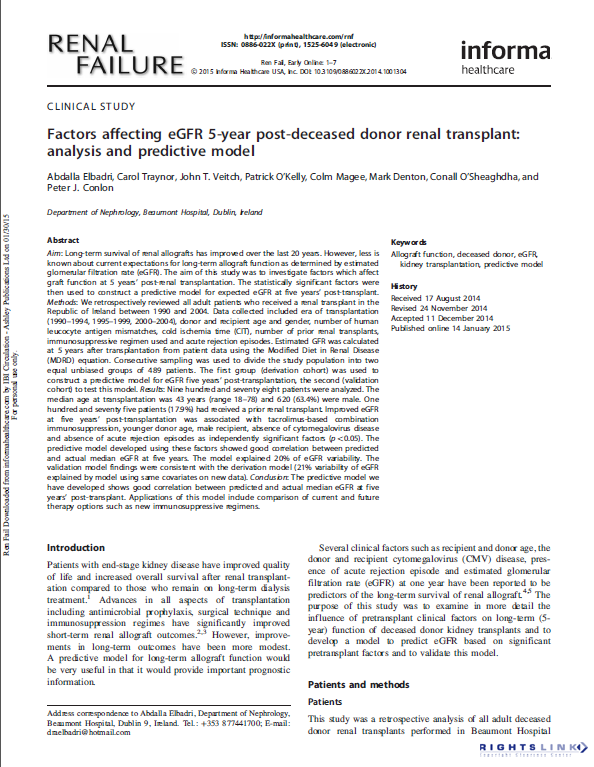
The aim of this study was to investigate factors which affect graft function at 5 years’ post-renal transplantation. The statistically significant factors were then used to construct a predictive model for expected eGFR at five years’ post-transplant.
Author: Abdalla Elbadri, Carol Traynor, John T. Veitch, Patrick O’Kelly, Colm Magee, Mark Denton, Conall O’Sheaghdha, and Peter J. Conlon.
Date: Ren Fail, Early Online: 1–7 2015. Informa Healthcare USA, Inc. DOI: 10.3109/0886022X.2014.1001304
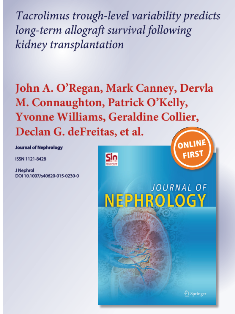
The purpose of this study is to investigate tacrolimus trough-level variability from 3 to 12 months following transplantation and its association with allograft survival in renal transplant recipients.
Author: John A. O’Regan, Mark Canney, Dervla M. Connaughton, Patrick O’Kelly, Yvonne Williams, Geraldine Collier, Declan G. deFreitas, Conall M. O’Seaghdha, Peter J. Conlon.
Date: J Nephrol, Sept 2015. DOI 10.1007/s40620-015-0230-0
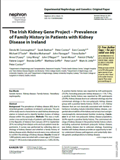
The prevalence of kidney disease (KD) due to inherited genetic conditions in Ireland is unknown. The aim of this study was to characterise an adult kidney disease population in Ireland and to identify familial clusters of kidney disease within the population.
Author: Dervla M. Connaughton, Sarah Bukhari, Peter Conlon, Eoin Cassidy, Michael O’Toole, Mardina Mohamad, John Flanagan, Triona Butler, Anne O’Leary, Limy Wong, John O’Regan, Sarah Moran, Patrick O’Kelly, Valerie Logan, Brenda Griffin, Matthew Griffin, Peter Lavin, Mark A. Little, Peter Conlon.
Date: Nephron 2015;130:65–73
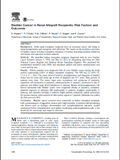
Cyclosporine is used extensively in kidney transplantation and is a substrate for cytochrome P450 enzymes. The role of cytochrome p450 polymorphisms in kidney transplant outcome has not yet been fully elucidated. We investigate the clinical impact of single nucleotide polymorphisms in CYP3A4, CYP3A5, PPARa, and POR*28 in 255 kidney transplant recipients.
Author: Carol Traynor, Peter Conlon Jr, Paul J. Phelan, Patrick O’Kelly, Laure Elens, Mark McCormack,
Gianpiero Cavalleri, Harry Comber, R.H.N. van Schaik, and Peter J. Conlon.
Date: Renal Failure, ISSN: 0886-022X (2015)

Solid organ transplant recipients have an increased cancer risk owing to immunosuppression and oncogenic viral infections. We report on the incidence and types of bladder cancer in kidney transplant recipients in Ireland, describing possible additional risk factors and outcomes in these patients.
Author: S. Medania, P. O’Kelly, K.M. O’Brien, P. Mohan, C. Magee, and P. Conlon.
Date: Transplantation Proceedings, 46, 3466e3473 (2014)
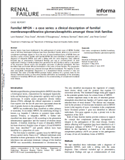
Genetic factors have been implicated in the pathogenesis of certain cases of MPGN. Familial cases of all three histological subtypes have been described. Genetic defects in the control of complement pathways appear to be at the root of many hereditary forms of MPGN. Here we describe a series of three families with familial MPGN. We have identified 3 individuals with a diagnosis of idiopathic MPGN, each with a sibling with the same diagnosis..
Author: Lynn Redahan, Ross Doyle, Michelle O’Shaughnessy, Anthony Dorman, Mark Little, and Peter Conlon
Date: Ren Fail, 2014; 36(8): 1333–1336
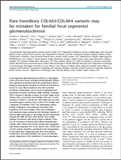
Focal segmental glomerulosclerosis (FSGS) is a histological lesion with many causes, including inherited genetic defects, with significant proteinuria being the predominant clinical finding at presentation. Mutations in COL4A3 and COL4A4 are known to cause Alport syndrome (AS), thin basement membrane nephropathy, and to result in pathognomonic glomerular basement membrane (GBM) findings.
Author: Andrew F. Malone, Paul J. Phelan, Gentzon Hall, Umran Cetincelik, Alison Homstad, Andrea S. Alonso, Ruiji Jiang, Thomas B. Lindsey, Guanghong Wu, Matthew A. Sparks, Stephen R. Smith, Nicholas J.A. Webb, Philip A. Kalra, Adebowale A. Adeyemo, Andrey S. Shaw, Peter J. Conlon, J. Charles Jennette, David N. Howell, Michelle P. Winn and Rasheed A. Gbadegesin
Date: Kidney International advance online publication, 17 September 2014; doi:10.1038/ki.2014.305
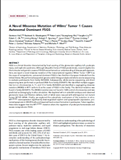
FSGS is a clinical disorder characterized by focal scarring of the glomerular capillary tuft, podocyte
injury, and nephrotic syndrome. Although idiopathic forms of FSGS predominate, recent insights into
themolecular and genetic causes of FSGS have enhanced our understanding of disease pathogenesis.
Here, we report a novel missense mutation of the transcriptional regulator Wilms’ Tumor 1 (WT1) as
the cause of nonsyndromic, autosomal dominant FSGS in two Northern European kindreds from the
United States.
Author: Gentzon Hall, Rasheed A. Gbadegesin, Peter Lavin,| Guanghong Wu, Yangfan Liu, Edwin C. Oh, Liming Wang, Robert F. Spurney, Jason Eckel, Thomas Lindsey, Alison Homstad, Andrew F. Malone, Paul J. Phelan, Andrey Shaw, David N. Howell, Peter J. Conlon, Nicholas Katsanis and Michelle P. Winn.
Date: J Am Soc Nephrol 26: 2014. doi: 10.1681/ASN.2013101053
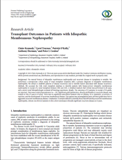
The natural history of idiopathic membranous nephropathy and recurrent disease in transplants is variable. We performed a retrospective cohort study of renal transplant recipients with a primary diagnosis of idiopathic membranous nephropathy. We aimed to establish patterns of disease recurrence and to identify factors associated with disease recurrence.
Author:Claire Kennedy, Carol Traynor, Patrick O’Kelly, Anthony Dorman and Peter J. Conlon.
Date: International Journal of Nephrology Volume 2013, Article ID 818537, 4 pages

Genetic factors have been implicated in the pathogenesis of certain cases of MPGN. Familial cases of all three histological subtypes have been described. Genetic defects in the control of complement pathways appear to be at the root of many hereditary forms of MPGN. Here we describe a series of three families with familial MPGN. We have identified 3 individuals with a diagnosis of idiopathic MPGN, each with a sibling with the same diagnosis..
Author: Lynn Redahan, Ross Doyle, Michelle O’Shaughnessy, Anthony Dorman, Mark Little, and Peter Conlon.
Date: 2014 Informa Healthcare USA, Inc. DOI: 10.3109/0886022X.2014.931681
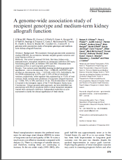
We examined, through genome-wide association studies (GWAS), the correlation between recipient genetic variation and renal function at five yr. Our cohort contained 326 Irish, first time, kidney-only, deceased donor, transplant recipients on calcineurin inhibitors (263 had a functioning graft at five yr) between 1993 and 2002. Outcomes were creatinine at five yr and long-term graft function.
Author: Robert P. O’Briena, Paul J. Phelanb, Judith Conroyc, Patrick O’Kelly , Andrew Greend, Mary Keogan, Derek O’Neill , Susan Jenning, Carol Traynor, Jillian Casey, Mark McCormack, Ronan Conroy, Anthony Chubb, Sean Ennis, Denis C. Shields, Gianpiero L. Cavalleri and Peter J. Conlon.
Date: Clin Transplant 2013: 27: 379–387 DOI: 10.1111/ctr.12093
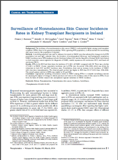
The incidence of nonmelanomatous skin cancer (NMSC) is substantially higher among renal transplant recipients (RTRs) than in the general population. With a growing RTR population, a robust method for monitoring skin cancer rates in this population is required. A modeling approach was used to estimate the trends in NMSC rates that adjusted for changes in the RTR population (sex and age), calendar time, the duration of posttransplant follow-up, and background population NMSC incidence rates.S.
Author: Finian J. Bannon, Jennifer A. McCaughan, Carol Traynor, Katie O’Brien, Anna T. Gavin, Alexander P. Maxwell, Harry Comber, and Peter J. Conlon.
Date: Transplant Journal, (2014). doi: 10.1097/TP.0000000000000115
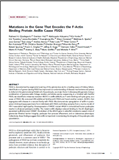
PFSGS is characterized by segmental scarring of the glomerulus and is a leading cause of kidney failure. Identification of genes causing FSGS has improved our understanding of disease mechanisms and points to defects in the glomerular epithelial cell, the podocyte, as a major factor in disease pathogenesis. Using a combination of genome-wide linkage studies and whole-exome sequencing in a kindred with familial FSGS, we identified a missense mutation R431C in anillin (ANLN), an F-actin binding cell cycle gene, as a cause of FSGS.
Author:Rasheed A. Gbadegesin,Gentzon Hall,Adebowale Adeyemo,Nils Hanke,Irini Tossidou, James Burchette, Guanghong Wu, Alison Homstad, Matthew A. Sparks, Jose Gomez, Ruiji Jiang, Andrea Alonso, Peter Lavin, Peter Conlon, Ron Korstanje, M. Christine Stander,|| Ghaidan Shamsan,| Moumita Barua, Robert Spurney, Pravin C. Singhal, Jeffrey B. Kopp, Hermann Haller, David Howell, Martin R. Pollak, Andrey S. Shaw, Mario Schiffer, and Michelle P. Winn.
Date: J Am Soc Nephrol 25, (2014). doi: 10.1681/ASN.2013090976
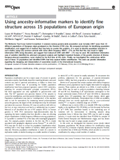
Population stratification can be a major cause of concern in genetic association studies. Specifically, imperfect matching between cases and controls can lead to spurious associations, or failure to detect true associations. Several ways of accounting for hidden population stratification have been proposed (genomic control (GC) correction, adjusting for ancestry-informative principal components (PCs)),
but these approaches are only applicable in genome-wide scale data.
Author: Laura M Huckins, Vesna Boraska, Christopher S Frankli, James AB Floyd, Lorraine Southam, Patrick F Sullivan, Cynthia M Bulik, David A Collier, Chris Tyler-Smith, Eleftheria Zeggini and Ioanna Tachmazidou.
Date: European Journal of Human Genetics (2014), 1–11
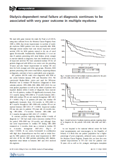
Although several studies have now shown improved overall survival (OS) for MM patients treated in the era of novel agents (bortezomib, lenalidomide, thalidomide), it is not yet clear if patients presenting with renal failure, severe enough to warrant dialysis at diagnosis, have also benefitted in terms of improved survival.
Author: Philip T Murphy, Cherisse Baldeo, Patrick O’Kelly, Jeremy Sargant, Patrick Thornton, Mary McCloy,Peter Conlon, Colm Magee, Mark Denton & John Quinn.
Date: British Journal of Haematology (2014) - doi:10.1111/bjh.12818
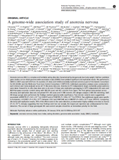
Anorexia nervosa (AN) is a complex and heritable eating disorder characterized by dangerously low body weight. Neither candidate gene studies nor an initial genome-wide association study (GWAS) have yielded significant and replicated results. We performed a GWAS in 2907 cases with AN from 14 countries (15 sites) and 14 860 ancestrally matched controls as part of the Genetic Consortium for AN (GCAN) and the Wellcome Trust Case Control Consortium 3 (WTCCC3).
Author: LV Boraska et, al.
Date: Molecular Psychiatry (2014), 1–10
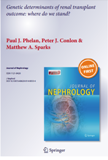
Donor and recipient genetic interplay influences kidney transplant outcome but our knowledge of these complex interactions is limited. Until recently, investigations have been limited to small candidate gene studies, usually restricted to allograft recipients.
Author: Paul J. Phelan, Peter J. Conlon & Matthew A. Sparks.
Date: J Nephrol DOI 10.1007/s40620-014-0053-4 (Feb 2014).
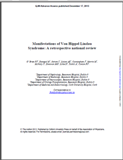
This study describes the presentation, natural history and manifestations of patients attending our institutions with this condition. We aim to highlight the importance of screening in diagnosing the manifestations of Von Hippel Lindau Syndrome (VHL).
Author: O’ Brien FJ, Danapal M, Jairam S, Lalani AK, Cunningham J, Morrin M, McNally S, Donovan MG, Little D, Tuthill A, Conlon PJ.
Date: QJM Advance Access published December 17, 2013
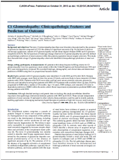
The full spectrumof histologic change observed in C3 glomerulopathy has yet to be defined and pathologic predictors of renal outcome within this patient population remain largely unknown. This study thus characterized a large C3 glomerulopathy cohort and identified clinicopathologic predictors of renal outcome.
Author: Nicholas R. Medjeral-Thomas,Michelle M. O’Shaughnessy,John A. O’Regan,Carol Traynor, Michael Flanagan, Limy Wong, Chia Wei Teoh, Atif Awan, Mary Waldron,| Tom Cairns, Patrick O’Kelly, Anthony M. Dorman, Matthew C. Pickering, Peter J. Conlon,and H. Terence Cook.
Date: Clin J Am Soc Nephrol 9, 2014.
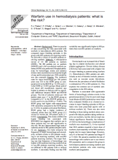
There is a paucity of data concerning the risks associated with warfarin in hemodialysis (HD) patients. We compared major bleeding episodes in this group with HD patients not receiving warfarin and with a cohort of non-HD patients receiving warfarin.
Author: P.J. Phelan, P. O’Kelly, J. Holian, J.J. Walshe, C. Delany, J. Slaby, S. Winders, D. O’Toole, C. Magee and P.J. Conlon.
Date: Clinical Nephrology, Vol. 75 – No. 3/2011 (204-211).
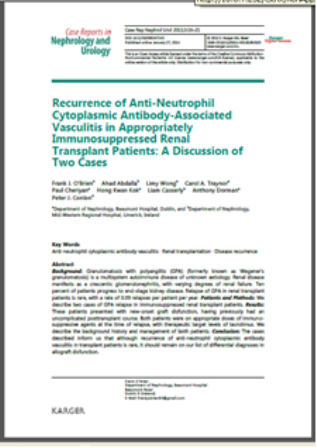
We describe two cases of GPA relapse in immunosuppressed renal transplant patients. Results: These patients presented with new-onset graft disfunction, having previously had an uncomplicated posttransplant course. Both patients were on appropriate doses of immunosuppressive agents at the time of relapse, with therapeutic target levels of tacrolimus.
Author: Frank J. O’Brien, Ahad Abdalla, Limy Wong, Carol A. Traynor, Paul Cheriyan, Hong Kwan Kok, Liam Casserly, Anthony Dorman, and Peter J. Conlon.
Date: Nephrol Urol 2013;3:16–21.
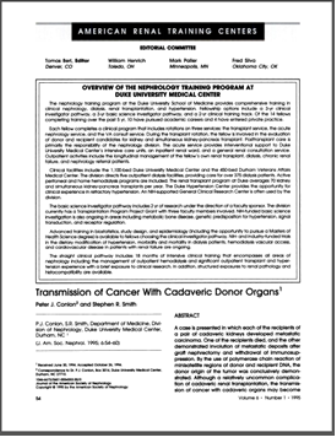
We assess our long-term experience with regards the safety and efficacy of Mycophenolate Mofetil
(MMF) in our low risk renal transplant population and compared it retrospectively to Azathioprine (AZA) immunosuppressive regimen.
Author: Omer A. Raheem, Padraig J. Daly, Patrick O’Kelly, William P. Shields, Antonio J. Zimmerman, Ponnusamy Mohan, Richard Power, Dilly M. Little, Peter J. Conlon andDavid P. Hickey.
Date: Nephrol Dial Transplant (2012) 27: 840–844.
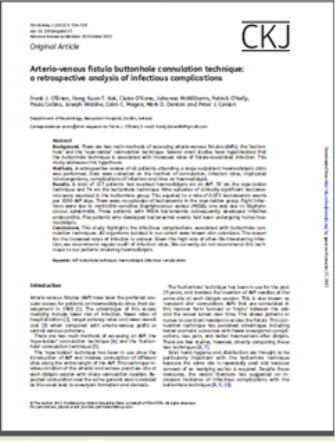
There are two main methods of accessing arterio-venous fistulas (AVFs); the ‘buttonhole’ and the ‘rope-ladder’ cannulation technique. Several small studies have hypothesized that the buttonhole technique is associated with increased rates of fistula-associated infection. This study addresses this hypothesis. A retrospective review of all patients attending a large outpatient haemodialysis clinic was performed. Data were collected on the method of cannulation, infection rates, implicated microorganisms, complications of infection and time on haemodialysis.
Author: Frank J. O’Brien, Hong Kuan T. Kok, Claire O’Kane, Johanna McWilliams, Patrick O’Kelly, Paula Collins, Joseph Walshe, Colm C. Magee, Mark D. Denton and Peter J. Conlon
Date: Clin Kidney J (2012) 5: 526–529.
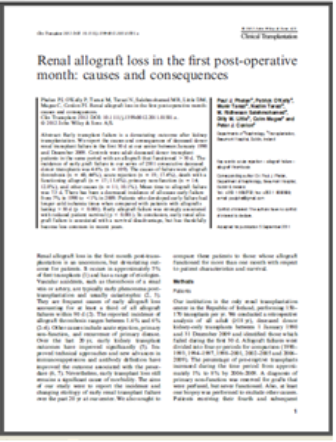
Early transplant failure is a devastating outcome after kidney transplantation. We report the causes and consequences of deceased donor renal transplant failure in the first 30 d at our center between January 1990 and December 2009.
Author: Paul J. Phelan, Patrick O'Kelly, Munir Tarazi, Nadim Tarazi, M. Ridhwaan Salehmohamed, Dilly M. Little, Colm Magee and Peter J. Conlon.
Date: Clin Transplant 2012 DOI: 10.1111/j.1399-0012.2011.01581.x.
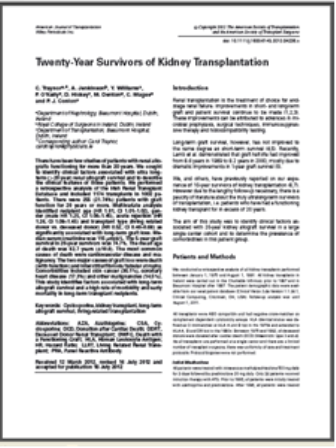
The aim of this study was to identify clinical factors associated with 20-year kidney allograft survival in a large single center cohort and to determine the prevalence of comorbidities in this patient group.
Author: C. Traynor, A. Jenkinson, Y. Williams, P. O’Kelly , D. Hickey, M. Denton, C. Magee and P. J. Conlon.
Date: American Journal of Transplantation doi: 10.1111/j.1600-6143.2012.04236.x
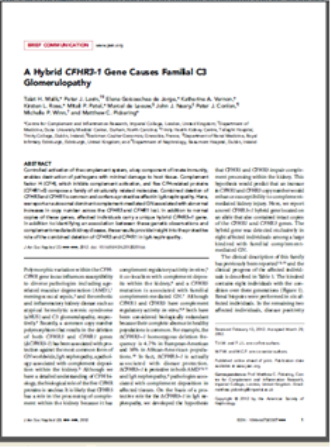
We report an autosomal dominant complement-mediatedGNassociated with abnormal increases in copy number across the CFHR3 and CFHR1 loci. In addition to normal copies of these genes, affected individuals carry a unique hybrid CFHR3–1 gene.
Author: Talat H. Malik, Peter J. Lavin, Elena Goicoechea de Jorge, Katherine A. Vernon,Kirsten L. Rose, Mitali P. Patel, Marcel de Leeuw, John J. Neary, Peter J. Conlon, Michelle P. Winn, and Matthew C. Pickering.
Date: J Am Soc Nephrol 23: 2012.
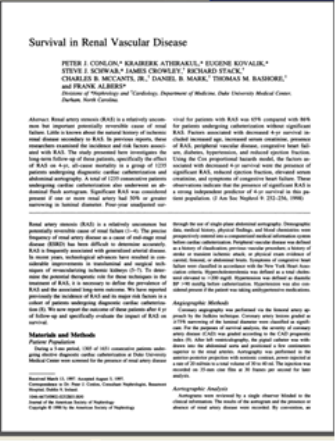
The study presented here investigates the long-term follow-up of these patients, specifically the effect
of RAS on 4-yr. all-cause mortality in a group of 1235 patients undergoing diagnostic cardiac catheterization and abdominal aortography.
Author: Peter J. Conlon, Krairerk Athirakul, Eugene Kovalik, Steve J. Schwab, James Crowley, Richard Stack, Charles B. McCants, JR., Daniel B. Mark, Thomas M. Bashore,and Frank Albers.
Date: American Society of Nephrology, Pg 252-255, 1998.
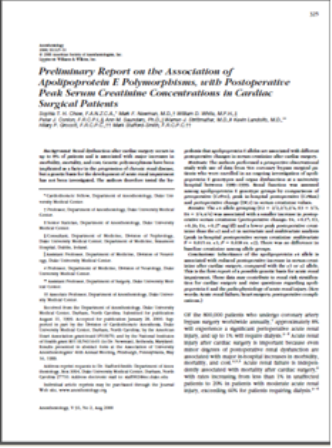
Genetic polymorphisms have been implicated as a factor in the progression of chronic renal disease,
but a genetic basis for the development of acute renal impairment has not been investigated. The authors therefore tested the hypothesis that apolipoprotein E alleles are associated with different postoperative changes in serum creatinine after cardiac surgery.
Author: Sophia T. H., Mark F. Newman, William D. White, Peter J. Conlon, Ann M. Saunders, Warren J. Strittmatter, Kevin Landolfo, Hilary P. Grocott, Mark Stafford-Smith.
Date: Anesthesiology, V 93, No 2, Aug 2000.
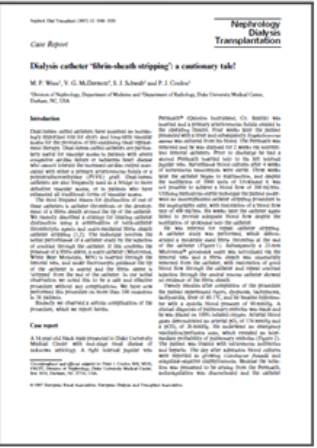
Cuffed central-venous haemodialysis catheters are emerging as an alternative permanent haemodialysis vascular access. There is limited data regarding the adequacy of dialysis with prolonged used of these catheters.
Author: Kraikerk Atherikul, Steve J. Schwab and Peter J. Conlon
Date: Nephrol Dial Transplant (1998) 13: 745–749.

Dual-lumen cued catheters have assumed an increasingly important role for short- and long-term vascular access for the provision of life-sustaining renal replacement therapy.
Author: M. P. Winn, V. G. McDermott, S. J. Schwab and P. J. Conlon
Date: Nephrol Dial Transplant (1997) 12: 1048–1050.
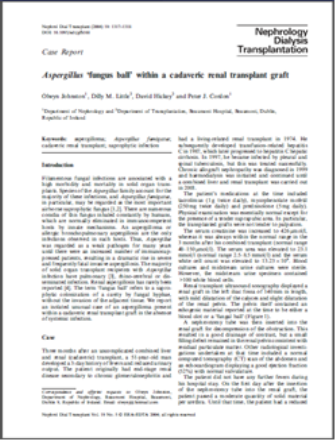
Dual-lumen cued catheters have assumed an increasingly important role for short- and long-term vascular access for the provision of life-sustaining renal replacement therapy.
Author: M. P. Winn, V. G. McDermott, S. J. Schwab and P. J. Conlon
Date: Nephrol Dial Transplant (1997) 12: 1048–1050.
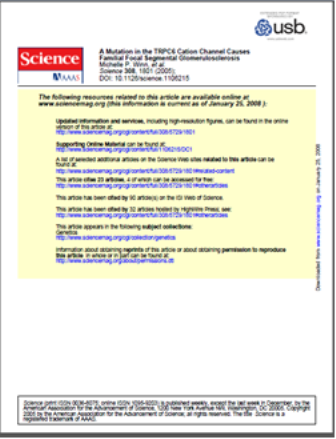
Focal and segmental glomerulosclerosis (FSGS) is a kidney disorder of unknown etiology, and up to 20% of patients on dialysis have been diagnosed with it. Here we show that a large family with hereditary FSGS carries a missense mutation in the TRPC6 gene on chromosome 11q, encoding the ion-channel protein transient receptor potential cation channel 6 (TRPC6).
Author: Michelle P. Winn, Peter J. Conlon, Kelvin L. Lynn, Merry Kay Farrington, Tony Creazzo, April F. Hawkins, Nikki Daskalakis,Shu Ying Kwan, Seth Ebersviller, James L. Burchette, Margaret A. Pericak-Vance, David N. Howell, Jeffery M. Vance, Paul B. Rosenberg
Date: SCIENCE VOL 308 17 JUNE 2005.
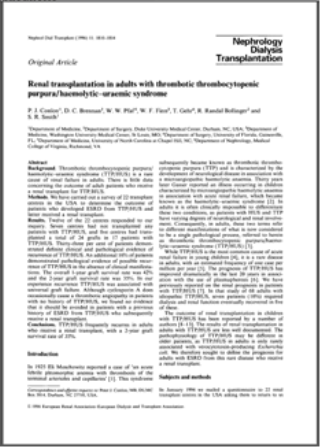
Thrombotic thrombocytopenic purpura/haemolytic-uraemic syndrome (TTP/HUS) is a rare cause of renal failure in adults. There is little data concerning the outcome of adult patients who receive a renal transplant for TTP/HUS.
Author: P. J. Conlon, D. C. Brennan, W. W. Pfaf, W. F. Finn, T. Gehr, R. Randal Bollinger and
S. R. Smith.
Date: Nephrol Dial Transplant (1996) 11: 1810-1814.
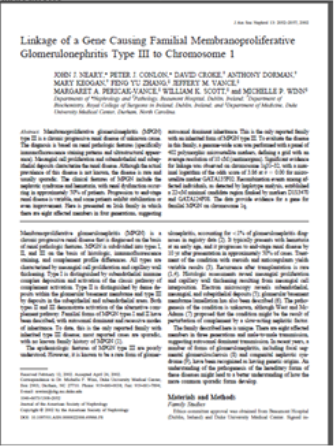
Here is presented an Irish family in which there are eight affected members in four generations, suggesting autosomal dominant inheritance. This is the only reported family with an inherited form of MPGN type III.
Author: John J. Neary, Peter J. Conlon, David Croke, Anthony Dorman, Mary Keogan, Feng Yu Zhang, Jeffery M. Vance, Margaret A. Pericak-Vance, William K. Scott, and Michelle P. Winn.
Date: J Am Soc Nephrol 13: 2052–2057, 2002.
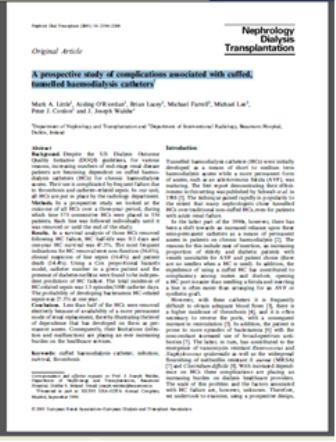
Here is presented an Irish family in which there are eight affected members in four generations, suggesting autosomal dominant inheritance. This is the only reported family with an inherited form of MPGN type III.
Author: John J. Neary, Peter J. Conlon, David Croke, Anthony Dorman, Mary Keogan, Feng Yu Zhang, Jeffery M. Vance, Margaret A. Pericak-Vance, William K. Scott, and Michelle P. Winn.
Date: J Am Soc Nephrol 13: 2052–2057, 2002.
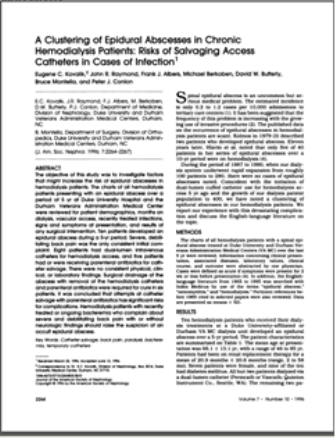
The objective of this study was to investigate factors that might increase the risk of epidural abscesses in hemodialysis patients. The charts of all hemodialysis patients presenting with an epidural abscess over a period of 5 yr at Duke University Hospital and the Durham Veterans Administration Medical Center were reviewed for patient demographics, months on dialysis, vascular access, recently treated infections, signs and symptoms at presentation, and results of any surgical intervention.
Author: Eugene C. Kovalik, John R. Raymond, Frank J. Albers, Michael Berkoben, David W. Butterly,
Bruce Montella, and Peter J. Conlon
Date: J. Am. Soc. Nephrol. 1996; 7:2264-2267.
vsimmediategraft1.png)
The purpose of this study was to define a parameter for DGF and immediate graft function (IGF) and to compare the graft outcome between these groups at our centre.
Author: Olwyn Johnston, Patrick O’Kelly, Susan Spencer, John Donohoe, J. Joseph Walshe,
Dilly M. Little, David Hickey and Peter J. Conlon.
Date: Nephrol Dial Transplant (2006) 21: 2270–2274.
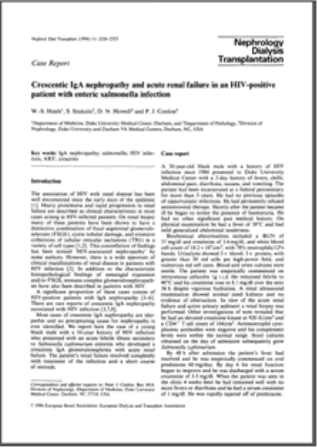
This case demonstrated a variety of renal pathological lesions, including crescentic IgA nephropathy and resolving acute tubular necrosis, in a patient with HIV infection.
Author: W.-S. Hsieh, S. Szukala, D. N. Howell and P. J. Conlon.
Date: Nephrol Dial Transplant (1996) 11: 2320-2323.
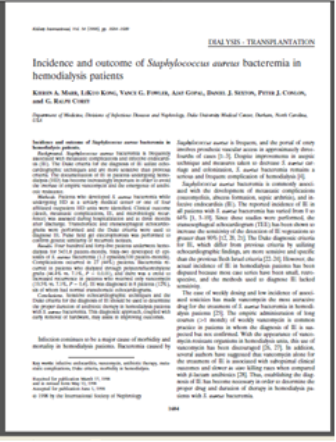
Staphylococcus aureus bacteremia is frequently associated wiht metastatic complications and infective endocaritis (IE). The Duke criteria for the diagnosis of IE utilises echocardiographic techniques and are more sensitive that previous criteria.
Author: Kierna A. Marr, LiKuo Kong, Vance G. Fowler, Ajay Gopal, Daniel J. Sexton, Peter J. Conlon and G. Ralph Corey.
Date: Kidney International Vol. 54 (1998), pp. 1684-1689.
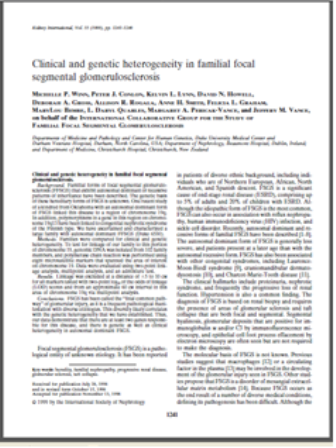
Families were compared for clinical and genetic heterogeneity. To test for linkage of our family to this portion of chromosome 19, genomic DNA was isolated from 102 family members, and polymerase chain reaction was performed using eight microsatellite markers that spanned the area of interest on chromosome 19.
Author: Michelle P. Winn, Peter J. Conlon, Kelvin L. Lynn, David N. Howell, Deborah A. Gross, Allison R. Rogala, Anne H. Smith, Felicia L. Graham, MaryLou Bembe, L. Daryl Quarles, Margaret A. Pericak-Vance, and Jeffery M. Vance.
Date: Kidney International Vol. 55 (1999), pp. 1241-11246.
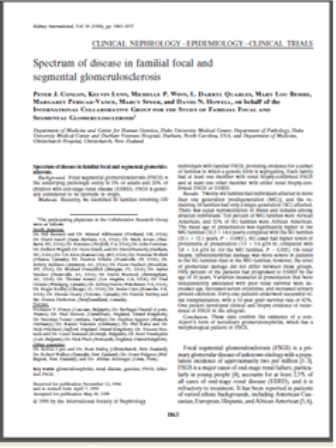
Focal segmental glomerulosclerosis (FSGS) is the underlying pathologic entity in 5% if adults and 20% of children with end-stage renal disease (ESRD). FSGS is generally considered to be sporadic in origin.
Author: Peter J. Conlon, Kelvin L. Lynn,Michelle P. Winn, L. Daryl Quarles, , MaryLou Bembe, Margaret A. Pericak-Vance, Marcy Speer and David N. Howell.
Date: Kidney International Vol. 56 (1999), pp. 1863-1871.
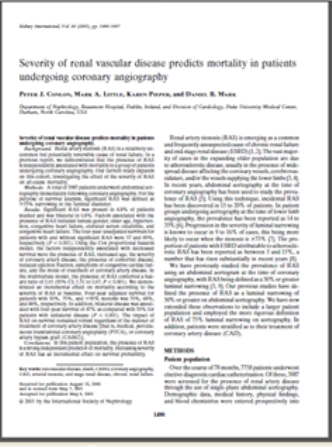
This study investigates the effect of the severity of Renal Artery Stenosis (RAS) on all-cause mortality.
Author: Peter J. Conlon, Mark A. Little, Karen Pieper, and Daniel B. Mark.
Date: Kidney International Vol. 60 (2001), pp. 1490-1497.
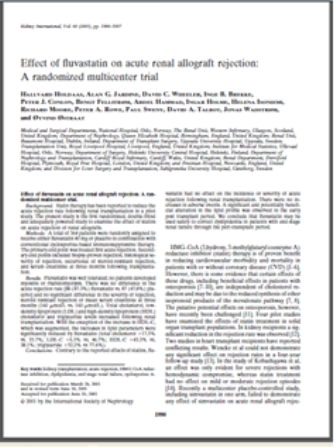
Statin therapy has been reported to reduce the acute rejection rate following renal transplantation in a pilot study. The present study is the first randomized, double-blind and adequately powered study to examine the effect of statins on acute rejection of renal allografts.
Author:Hallvard Holdaas, Alan G. Jardine, David C. Wheeler, Inge B. Brekke, Peter J. Conlon, Bengt Fellstrom, ABbdel Hammad, Ingar Holme, Helena Isoniemi, Richard Moore, Peter A. Rowe, Paul Sweny, David A. Talbot, Jonas Wadstrom, and Øyvind Østraat.
Date: Kidney International, Vol. 60 (2001), pp. 1990–1997.
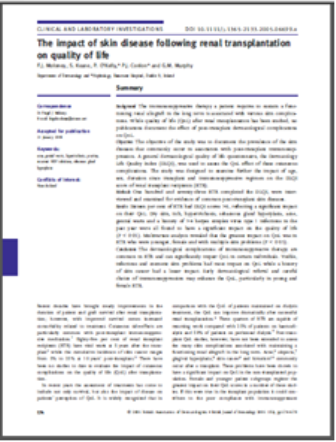
The objective of the study was to document the prevalence of the skin diseases that commonly occur in association with post-transplant immunosuppression. A general dermatological quality of life questionnaire, the Dermatology Life Quality Index (DLQI), was used to assess the QoL effect of these cutaneous complications. The study was designed to examine further the impact of age, sex, duration since transplant and immunosuppressive regimen on the DLQI score of renal transplant recipients (RTR).
Author:F.J. Moloney, S. Keane, P. O’Kelly, P.J. Conlon and G.M. Murphy.
Date: British Journal of Dermatology 2005 153, pp574–578.
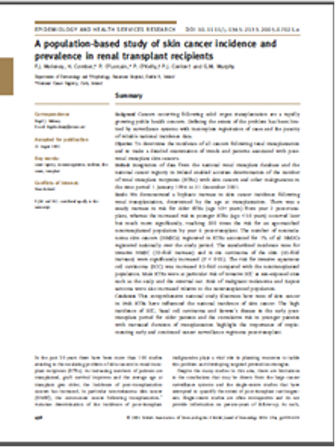
Cancers occurring following solid organ transplantation are a rapidly growing public health concern. Defining the extent of the problem has been limited by surveillance systems with incomplete registration of cases and the paucity of reliable national incidence data.
Author:F.J. Moloney, S. Keane, P. O’Kelly, P.J. Conlon and G.M. Murphy.
Date: British Journal of Dermatology 2006 154, pp498–504.
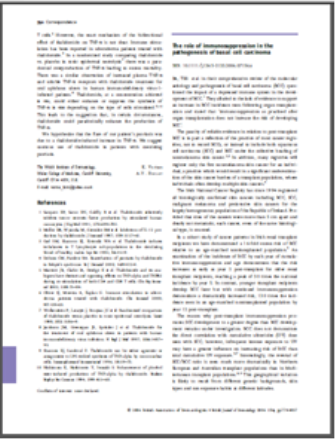
In a cohort study of cancer patterns in Irish renal transplant recipients we have demonstrated a 16-fold excess risk of BCC relative to an age-matched nontransplanted population.
Author:F.J. Moloney, S. Keane, P. O’Kelly, P.J. Conlon and G.M. Murphy.
Date: British Journal of Dermatology 2006 154, pp774–807.
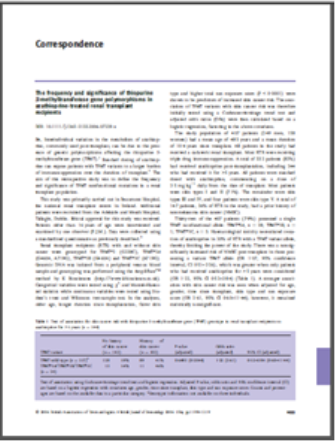
Interindividual variation in the metabolism of azathioprine, commonly used post-transplant, can be due to the presence of genetic polymorphisms affecting the thiopurine Smethyltransferase gene (TPMT).
Author:F.J. Moloney, P Dicker, D C. Shields, P.J. Conlon and G.M. Murphy.
Date: British Journal of Dermatology 2006 154, pp1199–1219.
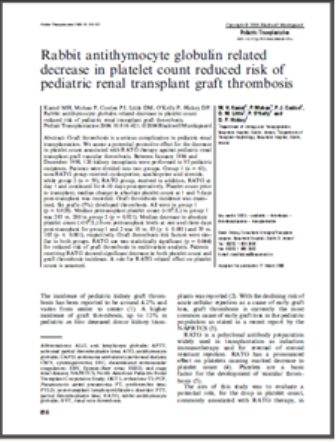
Graft thrombosis is a serious complication in pediatric renal transplantation. We assess a potential protective effect for the decrease in platelet count associated with RATG therapy against pediatric renal
transplant graft vascular thrombosis.
Author:M. H. Kamel, P. Mohan, P. J. Conlon, D. M. Little, P. O'Kelly and D. P. Hickey.
Date: Pediatr Transplantation 2006: 10: 816–821.
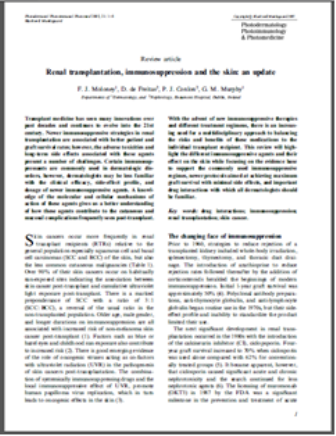
Newer immunosuppressive strategies in renal transplantation are associated with better patient and
graft survival rates; however, the adverse toxicities and long-term side effects associated with these agents present a number of challenges.
Author: F. J. Moloney, D. de Freitas, P. J. Conlon, G. M. Murphy.
Date: Photodermatol Photoimmunol Photomed 2005; 21: 1–8.
1.png)
Prolonged cold ischaemic time (CIT) is associated with delayed initial graft function and may also have a negactive impact on long-term graft outcome.
Author: Louise Giblin, Patrick O'Kelly, Dillie Little, David Hickey, John Donohue, Joseph J. Walshe, Susan Spencer and Peter J. Conlon.
Date: American Journal of Transplantation 2005; 5: 1071-1075.
1.png)
We investigated genetic association with SCC in two pathways associated with cancer risks, with potential for modification by vitamin supplementation.
Author: Laing Mary, Dicker Patrick, Moloney Fergal, Murphy Gillian, Conlon Peter and Shields Denis.
Date: The Official Journal of the Transplant Society-TPE-2006-0761.
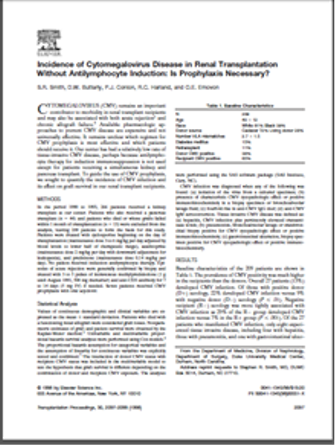
To guide the use of CMV prophylaxis, we sought to quantify the incidence of CMV infection and its effect on graft survival in our renal transplant recipients.
Author: S.R. Smith, D.W. Butterly, P.J. Conlon, R.C. Harland, and O.E. Emovon
Date: Transplantation Proceedings, 30, 2097–2099 (1998).
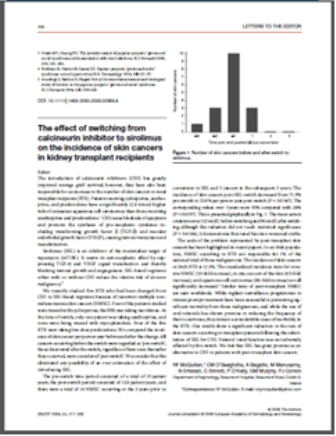
The introduction of calcineurin inhibitors (CNI) has greatly improved average graft survival; however, they have also been responsible for an increase in the number of skin cancers in renal transplant recipients (RTR).
Author: RF McQuillan,CM O’Seaghdha, A Bagatto, M Manusamy, N Errakiah, C Sinnott, P O’Kelly, GM Murphy, PJ Conlon.
Date: JEADV 2009, 23, 317–368.
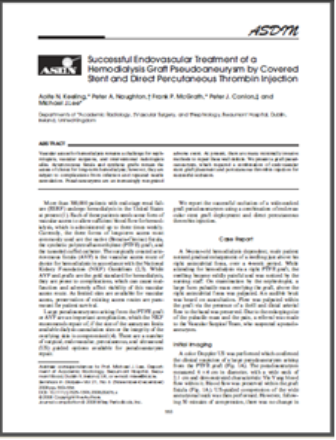
At present, there are many minimally invasive methods to repair these wall defects. We present a graft pseudoaneurysm, which required a combination of endovascular stent graft placement and percutaneous thrombin injection for successful occlusion.
Author: Aoife N. Keeling, Peter A. Naughton, Frank P. McGrath, Peter J. Conlon, and Michael J.Lee.
Date: ASDIN Seminars in Dialysis—Vol 21, No 6 (November–December) 2008 pp. 553–556.
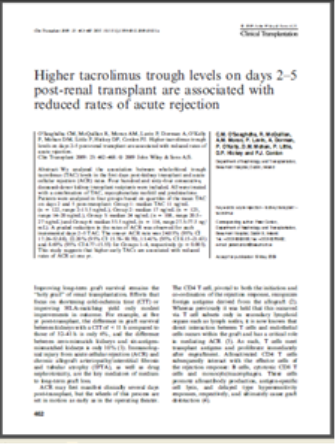
We analyzed the association between whole-blood trough tacrolimus (TAC) levels in the first days post-kidney transplant and acute cellular rejection (ACR) rates. Four hundred and sixty-four consecutive, deceased-donor kidney transplant recipients were included.
Author: C.M. O'Seaghdha, R. McQuillan, A.M. Moran, P. Lavin, A. Dorman, P. O'Kelly, D.M. Mohan, P. Little,
D.P. Hickey and P.J. Conlon
Date: Clin Transplant 2009: 23: 462–468 DOI: 10.1111/j.1399-0012.2009.01021.x.
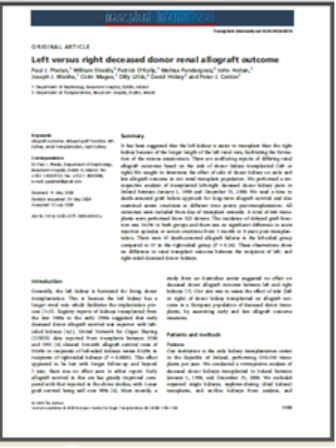
We sought to determine the effect of side of donor kidney on early and late allograft outcome in our renal transplant population. We performed a retrospective analysis of transplanted left–right deceased donor kidney pairs in Ireland between January 1, 1998 and December 31, 2008.
Author: Paul J. Phelan, William Shields, Patrick O’Kelly, Melissa Pendergrass, John Holian, Joseph J. Walshe, Colm Magee, Dilly Little, David Hickey and Peter J. Conlon
Date: European Society for Organ Transplantation 22 (2009) 1159–1163.
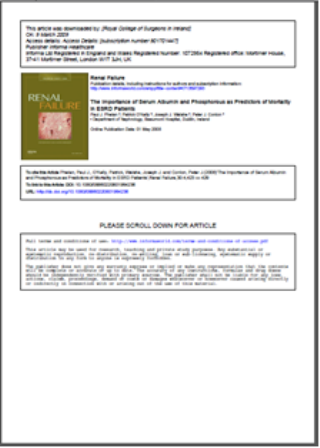
Using our renal database we analyzed outcomes on 1,007 chronic dialysis patients, commencing
dialysis between January 1990 and December 2004. The association between median values of serum phosphate, calcium, albumin (between three and six months post-commencement of dialysis), and long-term survival was examined.
Author: Paul J. Phelan, Patrick O’Kelly, Joseph J. Walshe, and Peter J. Conlon
Date: Renal Failure,30:4,423-429, 2008.
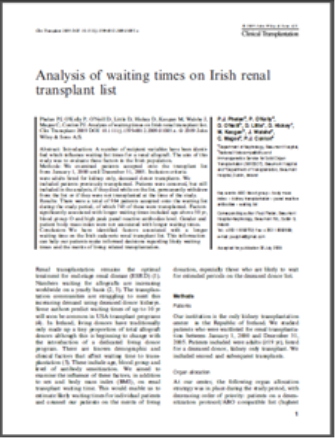
A number of recipient variables have been identified which influence waiting list times for a renal allograft. The aim of this study was to evaluate these factors in the Irish population.
Author: P.J. Phelan, P. O'Kelly, D. O'Neill, D. Little, D. Hickey, M. Keogan, J. Walshe, C. Magee, P.J. Conlon.
Date: Clin Transplant 2009,1399-1412.
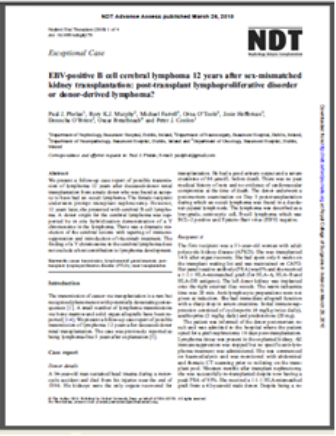
We present a follow-up case report of possible transmission of lymphoma 12 years after deceased-donor renal transplantation from a male donor who was found at autopsy to have had an occult lymphoma.
Author: Paul J. Phelan, Rory K.J. Murphy, Michael Farrell, Orna O’Toole, Josie Heffernan,Donncha O’Brien, Oscar Breathnach and Peter J. Conlon.
Date: Nephrol Dial Transplant (2010) 1 of 4.
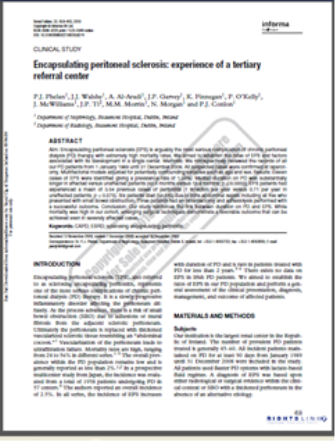
Encapsulating peritoneal sclerosis (EPS) is arguably the most serious complication of chronic peritoneal dialysis (PD) therapy with extremely high mortality rates. We aimed to establish the rates of EPS and factors associated with its development in a single center.
Author: P.J. Phelan, J.J. Walshe, A. Al-Aradi, J.P. Garvey, K. Finnegan, P. O’Kelly, J. McWilliams, J.P. Ti, M.M. Morrin, N. Morgan and P.J. Conlon.
Date: Renal Failure, 32, 459–463, 2010.
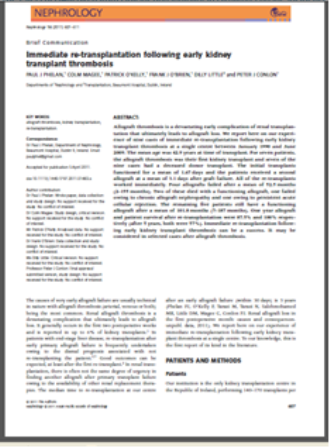
A number of recipient variables have been identified which influence waiting list times for a renal allograft. The aim of this study was to evaluate these factors in the Irish population.
Author: P.J. Phelan, P. O'Kelly, D. O'Neill, D. Little, D. Hickey, M. Keogan, J. Walshe, C. Magee, P.J. Conlon.
Date: Clin Transplant 2009,1399-1412.